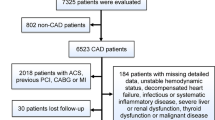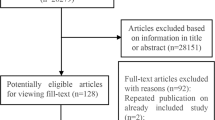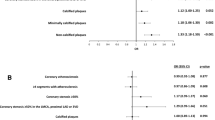Abstract
Cardiovascular disease remains a leading cause of death throughout the world despite advances in its detection and treatment. Commonly used risk algorithms, such as the Framingham Risk Score fail to identify all affected individuals. Novel cardiovascular risk factors that identify these missed individuals would greatly improve overall care of patients. C-reactive protein (CRP), an inflammatory biomarker, has emerged as a leading candidate to fulfill this role. Based on the results of several prospective epidemiologic studies, CRP has emerged as one of the most powerful predictors of cardiovascular disease. This marker provides valuable information to clinicians in various clinical settings, ranging from overt cardiovascular disease, stable angina, presenting acute coronary syndromes and peripheral vascular disease, to the metabolic syndrome. Furthermore, CRP has been demonstrated to actively contribute to all stages of atherogenesis, participating in endothelial dysfunction, atherosclerotic-plaque formation, plaque maturation, plaque destabilization and eventual rupture. Thus, it might also serve as a therapeutic target. It is our contention that the future will see much wider use of CRP and CRP-driven therapies in clinical medicine, improving our ability to identify and manage cardiovascular disease.
This is a preview of subscription content, access via your institution
Access options
Subscribe to this journal
Receive 12 print issues and online access
$209.00 per year
only $17.42 per issue
Buy this article
- Purchase on Springer Link
- Instant access to full article PDF
Prices may be subject to local taxes which are calculated during checkout


Similar content being viewed by others
References
Khot UN et al. (2003) Prevalence of conventional risk factors inpatients with coronary heart disease. JAMA 290: 898–904
Ridker PM et al. (2002) Comparison of C-reactive protein and low-density lipoprotein cholesterol levels in the prediction of first cardiovascular events. N Engl J Med 347: 1557–1565
Tice JA et al. (2003) The relation of C-reactive protein levels to total and cardiovascular mortality in older U.S. women. Am J Med 114: 199–205
Ridker PM et al. (2000) C-reactive protein and other markers of inflammation in the prediction of cardiovascular disease in women. N Engl J Med 342: 836–843
Biasucci LM et al. (1999) Elevated levels of C-reactive protein at discharge in patients with unstable angina predict recurrent instability. Circulation 99: 855–860
Ridker PM et al. (1998) Inflammation, pravastatin, and the risk of coronary events after myocardial infarction in patients with average cholesterol levels. Cholesterol and Recurrent Events (CARE) Investigators. Circulation 98: 839–844
Ridker PM et al. (2003) C-reactive protein, the metabolic syndrome, and risk of incident cardiovascular events: an 8 year follow-up of 14 719 initially healthy American women. Circulation 107: 391–397
Ridker PM (2002) Inflammatory biomarkers, statins, and the risk of stroke: cracking a clinical conundrum. Circulation 105: 2583–2585
Albert CM et al. (2002) Prospective study of C-reactive protein, homocysteine, and plasma lipid levels as predictors of sudden cardiac death. Circulation 105: 2595–2599
Ridker PM et al. (2001) Novel risk factors for systemic atherosclerosis: a comparison of C-reactive protein, fibrinogen, homocysteine, lipoprotein(a), and standard cholesterol screening as predictors of peripheral arterial disease. JAMA 285: 2481–2485
Blake GJ and Ridker PM (2002) C-reactive protein and prognosis after percutaneous coronary intervention. Eur Heart J 23: 923–925
Blake GJ et al. (2003) Blood pressure, C-reactive protein, and risk of future cardiovascular events. Circulation 108: 994–1000
Ridker PM et al. (1997) Inflammation, aspirin, and the risk of cardiovascular disease in apparently healthy men. N Engl J Med 336: 973–979
Ballantyne CM et al. (2004) Lipoprotein-associated phospholipase A2, high-sensitivity C-reactive protein, and risk for incident coronary heart disease in middle-aged men and women in the Atherosclerosis Risk in Communities (ARIC) study. Circulation 109: 837–842
Ridker PM et al. (2001) Measurement of C-reactive protein for the targeting of statin therapy in the primary prevention of acute coronary events. N Engl J Med 344: 1959–1965
Verma S et al. (2004) Cross-sectional evaluation of brachial artery flow-mediated vasodilation and C-reactive protein in healthy individuals. Eur Heart J 25: 1754–1760
Danesh J et al. (2004) C-reactive protein and other circulating markers of inflammation in the prediction of coronary heart disease. N Engl J Med 350: 1387–1397
Pearson TA et al. (2003) Markers of inflammation and cardiovascular disease: application to clinical and public health practice: A statement for healthcare professionals from the Centers for Disease Control and Prevention and the American Heart Association. Circulation 107: 499–511
Yeh ET and Willerson JT (2003) Coming of age of C-reactive protein: using inflammation markers in cardiology. Circulation 107: 370–371
Ridker PM and Cook N (2004) Clinical usefulness of very high and very low levels of C-reactive protein across the full range of Framingham risk scores. Circulation 109: 1955–1959
Pradhan AD et al. (2001) C-reactive protein, interleukin-6, and risk of developing type 2 diabetes mellitus. JAMA 286: 327–334
Ridker PM et al. (2004) Should C-reactive protein be added to metabolic syndrome and to the assessment of global cardiovascular risk? Circulation 109: 2818–2825
Sattar N et al. (2003) Metabolic syndrome with and without C reactive protein as a predictor of coronary heart disease and diabetes in the West of Scotland Coronary Prevention Study. Circulation 108: 414–419
Barzilay JI et al. (2001) The relation of markers of inflammation to the development of glucose disorders in the elderly: the Cardiovascular Health Study. Diabetes 50: 2384–2389
Thorand B et al. (1998) C-reactive protein as a predictor for incident diabetes mellitus among middle-aged men: results from the MONICA Ausburg cohort study, 1984–1998. Arch Intern Med 163: 93–99
Festa A et al. (2002) Elevated levels of acute-phase proteins and plasminogen activator inhibitor-1 predict the development of type 2 diabetes: the Insulin Resistance Atherosclerosis Study. Diabetes 51: 1131–1137
Hu FB et al. (2004) Inflammatory markers and risk of developing type 2 diabetes in women. Diabetes 53: 693–700
Szmitko PE et al. (2003) New markers of inflammation and endothelial cell activation: Part I. Circulation 108: 1917–1923
Torzewski M et al. (2000) C-reactive protein in the arterial intima: role of C-reactive protein receptor-dependent monocyte recruitment in atherosclerosis. Arterioscler Thromb Vasc Biol 20: 2094–2099
Verma S et al. (2002) A self-fulfilling prophecy: C-reactive protein attenuates nitric oxide production and inhibits angiogenesis. Circulation 106: 913–919
Verma S et al. (2002) Endothelin antagonism and interleukin-6 inhibition attenuate the proatherogenic effects of C-reactive protein. Circulation 105: 1890–1896
Venugopal SK et al. (2003) Venugopal SK C-reactive protein decreases prostacyclin release from human aortic endothelial cells. Circulation 108: 1676–1678
Verma S et al. (2004) C-reactive protein attenuates endothelial progenitor cell survival, differentiation and function: further evidence of a mechanistic link between CRP and cardiovascular disease. Circulation 109: 2058–2067
Szmitko PE et al. (2003) Endothelial progenitor cells: new hope for a broken heart. Circulation 107: 3093–3100
Khreiss T et al. (2004) Conformational rearrangement in C-reactive protein is required for proinflammatory actions on human endothelial cells. Circulation 109: 2016–2022
Verma S et al. (2003) C-reactive protein upregulates the nuclear factor-κB signal transduction pathway in saphenous vein endothelial cells: implications for atherosclerosis and restenosis. J Thorac Cardiovasc Surg 126: 1886–1891
Wang CH et al. (2003) C-reactive protein upregulates angiotensin type 1 receptors in vascular smooth muscle. Circulation 107: 1783–1790
Williams TN et al. (2004) C-reactive protein stimulates MMP-1 expression in U937 histiocytes through FcγRII and extracellular signal-regulated kinase pathway: an implication of CRP involvement in plaque destabilization. Arterioscler Thromb Vasc Biol 24: 61–66
Danenberg HD et al. (2003) Increased thrombosis after arterial injury in human C-reactive protein-transgenic mice. Circulation 108: 512–515
Paul A et al. (2004) C-reactive protein accelerates the progression of atherosclerosis in apolipoprotein E-deficient mice. Circulation 109: 647–655
Li SH et al. (2004) C-reactive protein upregulates complement inhibitory factors in endothelial cells. Circulation 109: 833–836
Zee RY and Ridker PM (2002) Polymorphism in the human C-reactive protein (CRP) gene, plasma concentrations of CRP, and the risk of future arterial thrombosis. Atherosclerosis 162: 217–219
Szalai AJ et al. (2002) Association between baseline levels of C-reactive protein (CRP) and a dinucleotide repeat polymorphism in the intron of the CRP gene. Genes Immun 3: 14–19
Brull DJ et al. (2003) Human CRP gene polymorphism influences CRP levels: implications for the prediction and pathogenesis of coronary heart disease. Arterioscler Thromb Vasc Biol 23: 2063–2069
Wadham C et al. (2004) High-density lipoproteins neutralize C-reactive protein proinflammatory activity. Circulation 109: 2116–2122
Ridker PM et al. (1999) Long-term effects of pravastatin on plasma concentration of C-reactive protein. Circulation 100: 230–235
Albert MA et al. (2001) Effect of statin therapy on C-reactive protein levels: the pravastatin inflammation/CRP evaluation (PRINCE): a randomized trial and cohort study. JAMA 286: 64–70
Kinlay S et al. (2003) High-dose atorvastatin enhances the decline in inflammatory markers in patients with acute coronary syndromes in the MIRACL study. Circulation 108: 1560–1566
Nissen SE et al. (2004) Effect of intensive compared with moderate lipid-lowering therapy on progression of coronary atherosclerosis: a randomized controlled trial. JAMA 291: 1071–1080
Ridker PM on behalf of the JUPITER study group (2003) Rosuvastatin in the primary prevention of cardiovascular disease among patients with low levels of low-density lipoprotein cholesterol and elevated high-sensitivity C-reactive protein: Rationale and design of the JUPITER trial. Circulation 108: 2292–2297
Ridker PM et al. (2004) Interrelationships of LDL cholesterol and hsCRP in the PROVE-IT clinical trial comparing intensive versus moderate lipid-lowering strategies among patients with acute coronary syndromes. Circulation 110: III–499
Author information
Authors and Affiliations
Corresponding author
Ethics declarations
Competing interests
Paul Ridker is listed as a co-inventor on patents held by the Brigham and Women's Hospital that pertain to the use of inflammatory biomarkers in cardiovascular disease.
Rights and permissions
About this article
Cite this article
Verma, S., Szmitko, P. & Ridker, P. C-reactive protein comes of age. Nat Rev Cardiol 2, 29–36 (2005). https://doi.org/10.1038/ncpcardio0074
Received:
Accepted:
Issue Date:
DOI: https://doi.org/10.1038/ncpcardio0074
This article is cited by
-
Visualization of atherosclerosis as detected by coronary artery calcium and carotid intima-media thickness reveals significant atherosclerosis in a cross-sectional study of psoriasis patients in a tertiary care center
Journal of Translational Medicine (2016)
-
Local and systemic responses following intravitreous injection of AAV2-encoded modified Volvox channelrhodopsin-1 in a genetically blind rat model
Gene Therapy (2016)
-
Innate sensing of oxidation-specific epitopes in health and disease
Nature Reviews Immunology (2016)
-
Interactions of genetic and non-genetic factors on plasma hs-CRP concentration in a Korean community-based cohort study
Genes & Genomics (2015)
-
Prognostic Value of Mannose-Binding Lectin: 90-Day Outcome in Patients with Acute Ischemic Stroke
Molecular Neurobiology (2015)



